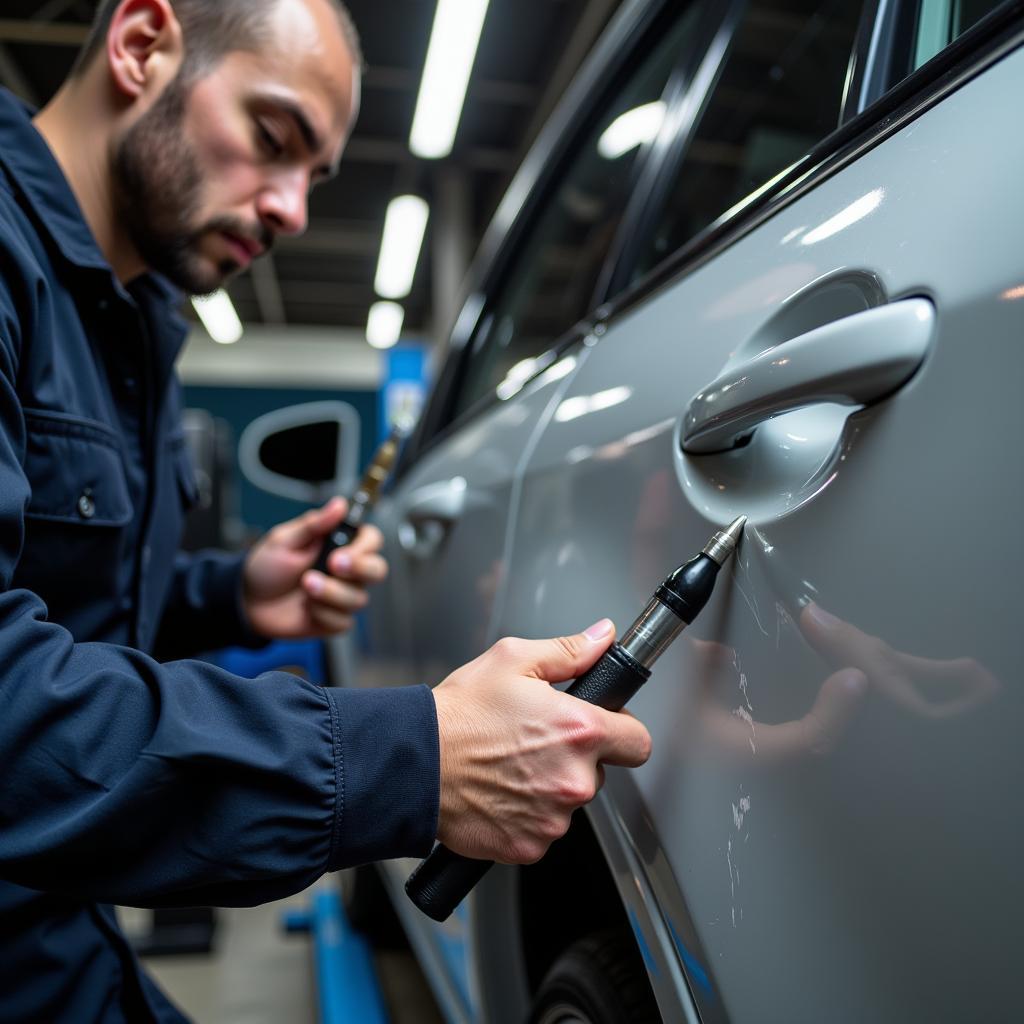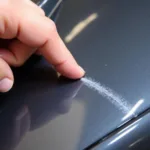Dealing with car scratch paint can be frustrating, but thankfully, many repairs can be handled at home without professional help. Knowing how to assess the damage and choose the right repair method can save you time and money. This guide will walk you through various techniques for repairing car scratch paint, from minor scuffs to deeper scratches.
Whether your car suffered a keying incident, a parking lot mishap, or simply brushed against a rogue shopping cart, understanding the nature of the scratch is the first step to a successful repair. Is it a clear coat scratch, a primer scratch, or has it gone down to the bare metal? The answer will determine your next course of action. For minor clear coat scratches, a simple polishing compound might suffice. However, deeper scratches that penetrate the primer or expose the metal require more involved techniques. This article will equip you with the knowledge to identify the damage and tackle the repair effectively. Check out our guide on long scratch car paint repair for more comprehensive information about dealing with those pesky long scratches.
Assessing the Scratch Damage
Before you start repairing car scratch paint, it’s crucial to assess the extent of the damage. Wash the area thoroughly with car wash soap and water to remove any dirt or debris. This will give you a clear view of the scratch. Run your fingernail across the scratch. If your nail catches, the scratch has likely penetrated the clear coat and requires more than just polishing.
Determining Scratch Depth
There are three main levels of car scratch paint damage:
- Clear Coat Scratch: These are the most superficial scratches and only affect the clear coat, the topmost layer of your car’s paint. They often appear as light, hazy marks.
- Primer Scratch: These scratches are deeper and reach the primer layer beneath the clear coat. They appear more noticeable and may be slightly discolored.
- Base Coat/Metal Scratch: The deepest type of scratch, these reach the base coat or even the bare metal of the car. These scratches require more extensive repair to prevent rust and further damage.
DIY Car Scratch Repair Methods
For minor clear coat scratches, you might be able to get away with a simple DIY repair. Here’s a breakdown of common methods:
Using a Car Scratch Remover
Car scratch removers are abrasive compounds designed to level out minor scratches in the clear coat. Apply a small amount of the product onto a microfiber cloth and rub it onto the scratch using circular motions. Buff the area until the scratch disappears. You can also find information about the cost to repair car paint scratch on our dedicated page.
Touch-Up Paint for Deeper Scratches
If you’re dealing with a primer scratch, touch-up paint is your best bet. Before starting, ensure the area is clean and dry. Apply the touch-up paint carefully, only filling the scratch. Avoid applying too much paint, as it can create a raised area. For deeper scratches, you may need multiple coats, allowing each coat to dry completely before applying the next. Need your car scratch fixed without leaving your home? Consider our mobile car paint scratch repair services.
Wet Sanding for Severe Scratches
For deeper scratches that reach the base coat or metal, wet sanding is often necessary. This method involves using progressively finer grits of sandpaper to level the area around the scratch. It requires careful execution and is best left to experienced individuals. Improper wet sanding can worsen the damage.
When to Call a Professional
While many minor scratches can be tackled at home, some situations call for professional help. If the scratch is deep and extensive, or if it’s in a prominent location, it’s best to consult a professional. They have the expertise and tools to provide a seamless repair. Looking for a specific repair pen in New Zealand? Check out our car paint scratch repair pen nz page. We also offer services in Dorset – see our car paint scratch repair dorset page.
 Professional Car Scratch Repair
Professional Car Scratch Repair
Conclusion
Repairing car scratch paint can seem daunting, but understanding the type of damage and choosing the appropriate method can make the process manageable. From using a simple scratch remover to employing more advanced techniques like wet sanding, there are various ways to restore your car’s appearance. However, remember that for severe scratches or if you’re unsure about DIY methods, seeking professional help is always the best course of action. This ensures a flawless finish and prevents further damage to your vehicle.
FAQ
- Can I use toothpaste to repair car scratches? While toothpaste can sometimes mask very superficial scratches, it’s not a long-term solution.
- How do I choose the right touch-up paint? Your car’s VIN will help you find the exact color code for your car’s paint.
- What is the best way to prevent car scratches? Regular washing and waxing can help protect your car’s paint from minor scratches.
- Can I wax my car after repairing a scratch? Yes, after the repair area is fully cured, you can wax your car.
- Is wet sanding safe for all car paint types? No, consult a professional before wet sanding, especially if your car has a specialized paint finish.
- How long does touch-up paint take to dry? Drying times vary, but it’s usually best to wait at least 24 hours before waxing or polishing.
- What are the signs I’ve sanded too much? If you start to see the primer or metal, you’ve sanded too much.
Common Car Scratch Scenarios and Solutions
- Light scratches from car washes: Use a car scratch remover.
- Scratches from tree branches: Depending on the depth, you can try touch-up paint or a scratch remover.
- Key scratches: These are often deep and require professional repair.
Further Reading and Resources
Check out our articles on mobile car paint scratch repair and cost to repair car paint scratch for more information.
For support, contact us via WhatsApp: +1(641)206-8880, or Email: [email protected]. We have a 24/7 customer support team.

